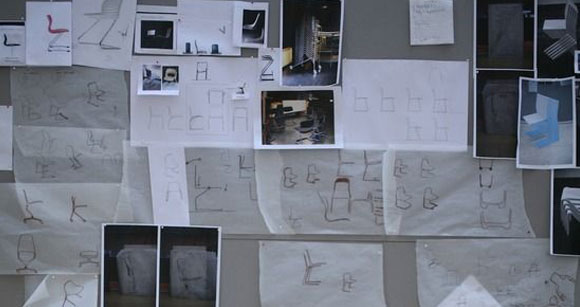
Sketches for the Tip Ton chair, by Barber Osgerby. Photo by Felix Friedmann, courtesy Disegno
The first issue of design, architecture and fashion magazine Disegno includes my 3,000-word essay on Barber Osgerby’s Tip Ton chair for Vitra and the process behind its making. It was a challenge and an honour to write this piece, and I was very pleased with the result. The magazine can (and should!) be bought here, and the full feature article can be read online over at Disegno Daily. An excerpt after the jump.
Formally, the Tip Ton echoes an earlier Barber Osgerby design: the 2002 wooden Portsmouth bench, originally designed for the choir stalls of the Portsmouth cathedral. Despite the different materials, the same simple, gently curved lines inhabit the two, as if this was Barber Osgerby’s chair archetype. The designers see it as a matter of simplification. “It had to be a lightweight piece of furniture, so in the end we were doing the same thing, I suppose, in a different material,†Barber says. “We were quite conscious that we wanted the chair to feel like it referred to the average type of a school chair too,†Osgerby adds. “So it didn’t feel alien to the environment.†And when, in 2009, Anniina Koivu took the chair to the Casa del Sole school near Milan, as part of a follow-up feature on furniture design for schools at Abitare, the kids instantly got it. The feature proclaimed Barber Osgerby and Vitra were “about to remedy the dearth of choice in school furniture as they take the ‘good design’ of office chairs into the classroom.â€
With such accolades being handed out it is surprising then that the context of the school has been stripped away completely in the way that the Tip Ton is promoted. The Tip Ton is now, as Maise put it, “more of a universal chairâ€, sold as part of the Vitra standard line as a multipurpose – and for adults, not for kids. Looking at the Tip Ton entry in the Vitra online catalogue, there’s a woman sitting at home, exemplifying the chair’s two positions. The only reference to schools comes at the end of the chair’s description. “Thanks to its striking appearance, Tip Ton is an outstanding dining table or home-office solution,†the Vitra website proclaims. “It is also ideal for use in restaurants, conference and meeting spaces and educational institutions.†So what about bringing “good design†into schools?
“I feel uncomfortable when people talk about Tip Ton as a social project, because it isn’t, really,†Osgerby says, “Not in the way that we now talk about social and ethical projects. It isn’t. It’s a commercial [project], with a benefit. And hopefully there’s a good enough idea behind it for it to be a commercial success.†As such, there won’t be a massive distribution of chairs in every school of the western world. As a Vitra chair, the Tip Ton will be sold and distributed within the Vitra network. “You can’t just start selling school furniture, because you have to be part of a system,†Barber says. “Vitra isn’t in that system yet. Over the next few years they will definitely move into that area.â€
With the ideology that helped form the Tip Ton chair gone at this last stage of the process that started at the Academy in Tipton in 2008, it is difficult to look at the chair with the same sincerity that its creators are asking for. And if its merits are now different, then the Tip Ton sits within another system of chairs. Not as the next step in the evolution of seating for educational institutions, but as yet another chair that launched in the vast halls of the Fiera Milano in Rho, 2011. As such it faces entirely different competition, its unique characteristic being the nine-degree angle at the front of its skids, a design quirk that doesn’t speak of its origins in the dire landscape of educational furniture. However, if the original agenda was followed, the Tip Ton could be a game-changer for a generation.